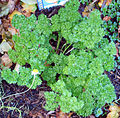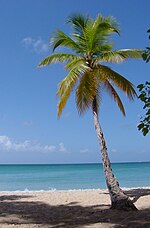Flowering plants are plants that bear flowers and fruits, and form the clade Angiospermae (/ˌændʒiəˈspərmiː/), commonly called angiosperms. They include...
80 KB (6,316 words) - 13:41, 23 September 2024
reproduction of flowering plants, the first is the timing of flowering and the other is the size or number of flowers produced. Often plant species have...
26 KB (3,245 words) - 02:29, 28 September 2024
genetic structure of nonclonal plant populations. Christian Konrad Sprengel (1793) studied the reproduction of flowering plants and for the first time it was...
29 KB (2,959 words) - 04:59, 23 August 2024
included only flowering plants possessing seeds enclosed in capsules, distinguished from his Gymnospermae, which were flowering plants with achenial or...
14 KB (1,567 words) - 22:57, 9 May 2024
liverworts, mosses, lycophytes, ferns, conifers and other gymnosperms, and flowering plants). A definition based on genomes includes the Viridiplantae, along with...
95 KB (8,057 words) - 17:06, 22 September 2024
A biennial plant is a flowering plant that, generally in a temperate climate, takes two years to complete its biological life cycle. In its first year...
5 KB (599 words) - 05:48, 27 May 2024
Botany (redirect from Plant biology)
000 species of land plants, including some 391,000 species of vascular plants (of which approximately 369,000 are flowering plants) and approximately 20...
138 KB (14,771 words) - 04:05, 28 September 2024
Hermaphrodite (redirect from Hermaphroditic plant)
known hermaphroditic species among mammals or birds. About 94% of flowering plant species are either hermaphroditic (all flowers produce both male and...
51 KB (5,137 words) - 09:59, 1 August 2024
history of flowering plants records the development of flowers and other distinctive structures of the angiosperms, now the dominant group of plants on land...
27 KB (2,890 words) - 22:22, 26 September 2024
Sexual reproduction (redirect from Sexual reproduction in flowering plants)
angiosperms have as few as three cells in each pollen grain. Flowering plants are the dominant plant form on land: 168, 173 and they reproduce either sexually...
39 KB (4,845 words) - 01:56, 30 September 2024
parasitic plants in approximately 20 families of flowering plants are known. There is a wide range of effects that may occur to a host plant due to the...
29 KB (3,338 words) - 16:02, 26 September 2024
bryophylla is the highest flowering plant in the world, occurring as high as 6,180 m (20,280 ft). To survive, alpine plants are adapted to the conditions...
22 KB (2,561 words) - 22:02, 14 April 2024
Perennial (redirect from Perennial plant)
exceeding two years in the botanical world. Perennials (especially small flowering plants) that grow and bloom over the spring and summer, die back every autumn...
23 KB (2,728 words) - 14:31, 12 September 2024
Cornus kousa (redirect from Japanese Flowering Dogwood)
Cornus kousa is a small deciduous tree 8–12 m (26–39 ft) tall, in the flowering plant family Cornaceae. Common names include kousa, kousa dogwood, Chinese...
16 KB (1,145 words) - 00:21, 30 September 2024
in animal evolution but, with plants, it is often overlooked because many plants are hermaphrodites. Flowering plants show many characteristics that...
12 KB (1,563 words) - 01:25, 1 August 2024
Sex (redirect from Sex in plants)
development of the embryonic plant. The flowers of flowering plants contain their sexual organs. Most flowering plants are hermaphroditic, with both...
66 KB (7,646 words) - 11:51, 30 August 2024
Dicotyledon (redirect from Dicotyledonous Plants)
more rarely, dicotyls), are one of the two groups into which all the flowering plants (angiosperms) were formerly divided. The name refers to one of the...
14 KB (784 words) - 08:32, 22 September 2024
plants, such as wood formation. Biennial plant – Flowering plant that takes two years to complete its biological life cycle Perennial plant – Plant that...
13 KB (1,388 words) - 05:12, 13 September 2024
division of plants, with upwards of 400,000 species. For two-dimensional area, the largest known clonal flowering plant, and indeed largest plant and organism...
17 KB (1,856 words) - 16:33, 24 September 2024
Acanthus is a genus of about 30 species of flowering plants in the family Acanthaceae, native to tropical and warm temperate regions, with the highest...
9 KB (778 words) - 08:41, 21 August 2024
Coevolution (redirect from Insect-flowering plant coevolution)
between flowering plants and insects in On the Origin of Species (1859). Although he did not use the word coevolution, he suggested how plants and insects...
49 KB (5,373 words) - 11:14, 21 August 2024
Spikenard (redirect from Nardin (plant))
amber-colored essential oil derived from Nardostachys jatamansi, a flowering plant in the honeysuckle family which grows in the Himalayas of Nepal, China...
13 KB (1,387 words) - 14:02, 23 September 2024
Fertilisation (section Flowering plants)
through the pollen tube to the ovule where the egg is fertilised. In flowering plants, two sperm cells are released from the pollen tube, and a second fertilisation...
45 KB (5,218 words) - 23:47, 26 August 2024
Flowering synchrony is the amount of overlap between flowering periods of plants in their mating season compared to what would be expected to occur randomly...
35 KB (4,288 words) - 19:15, 21 June 2024
Poppy (redirect from Poppy plant)
A poppy is a flowering plant in the subfamily Papaveroideae of the family Papaveraceae. Poppies are herbaceous plants, often grown for their colourful...
16 KB (1,808 words) - 13:43, 31 July 2024
Arecaceae (redirect from Palm (plant))
of perennial, flowering plants in the monocot order Arecales. Their growth form can be climbers, shrubs, tree-like and stemless plants, all commonly known...
61 KB (6,113 words) - 14:42, 22 September 2024
eventually to the complex seed-bearing gymnosperms and angiosperms (flowering plants) of today. While many of the earliest groups continue to thrive, as...
138 KB (17,232 words) - 00:43, 27 September 2024
Pilea peperomioides (redirect from Chinese Money Plant)
pɛpəˌroʊmiˈɔɪdiːz/), the Chinese money plant, UFO plant, pancake plant, lefse plant or missionary plant, is a species of flowering plant in the nettle family Urticaceae...
9 KB (1,042 words) - 02:37, 12 September 2024
Hypoestes phyllostachya (redirect from Polka Dot Plant)
Hypoestes phyllostachya, the polka dot plant, is a species of flowering plant in the family Acanthaceae, native to South Africa, Madagascar, and south...
5 KB (489 words) - 05:14, 5 May 2024

























